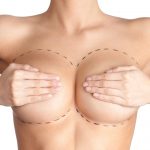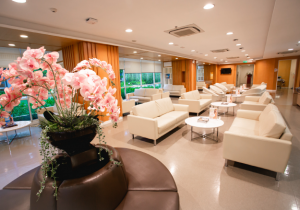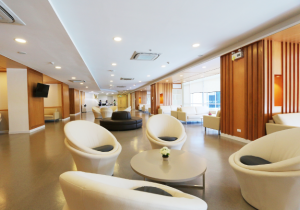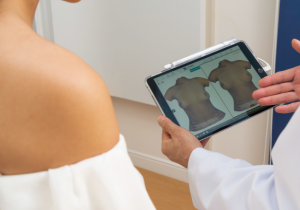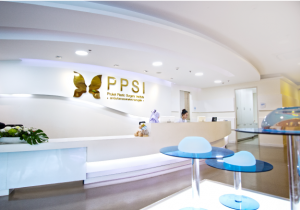Breast Augmentation
Breast augmentation is a cosmetic surgery procedure for women to increase breast size which involves placing breast implants under the breast tissue or chest muscles.
It is a cosmetic surgery procedure that helps women who are dissatisfied with the size of their breasts. It also assists women who have experienced changes in the appearance of their breasts due to pregnancy, breast-feeding, weight-loss, genetics, sun exposure, gravity, hormones, or any number of changes to the size and shape of your breasts.
It is also referred to as “breast enhancement”, “breast implants”, and most commonly as “a boob job” while the, in the plastic surgery world the correct term is an augmentation mammoplasty.
As with all surgical procedures, you should consider whether breast augmentation is suitable for you before deciding to go ahead and ask your surgeon/agency any questions that you may have and he or she will give you guidance and advice to make sure that your choice is fully-informed and for reasons such as personal preference.
It is a cosmetic surgery procedure that helps women who are dissatisfied with the size of their breasts. It also assists women who have experienced changes in the appearance of their breasts due to pregnancy, breast-feeding, weight-loss, genetics, sun exposure, gravity, hormones, or any number of changes to the size and shape of your breasts.
It is also referred to as “breast enhancement”, “breast implants”, and most commonly as “a boob job” while the, in the plastic surgery world the correct term is an augmentation mammoplasty.
As with all surgical procedures, you should consider whether breast augmentation is suitable for you before deciding to go ahead and ask your surgeon/agency any questions that you may have and he or she will give you guidance and advice to make sure that your choice is fully-informed and for reasons such as personal preference.
Surgical Procedure
Breast augmentation is performed by placing breast implants either under the breast tissue (under the muscle) and over the chest muscle (over the muscle), or under both the chest muscle and the breast tissue (dual plane). All breast implants are made with a silicone-based casing but they are filled with either silicone gel or saline. The outer silicone case may be smooth, shiny, polished, or a slightly rough texture.
The type, style, and size of breast implants you choose are determined by your lifestyle, body contours, the amount of breast tissue you have, and the cup size and appearance that you would like to achieve. Choosing the breast implant option that is right and suitable should be consulted with a surgeon.
In terms of methods of incision and insertion, this is discussed in consultation between yourself and the consulting Plastic Surgeon, in respect to best results and decided upon after physical examination at the time of consultation. The most commonly used methods of incision and insertion in the following areas:
The type, style, and size of breast implants you choose are determined by your lifestyle, body contours, the amount of breast tissue you have, and the cup size and appearance that you would like to achieve. Choosing the breast implant option that is right and suitable should be consulted with a surgeon.
In terms of methods of incision and insertion, this is discussed in consultation between yourself and the consulting Plastic Surgeon, in respect to best results and decided upon after physical examination at the time of consultation. The most commonly used methods of incision and insertion in the following areas:
Hospital Admission
Duration of Operation
Anaesthetic
Pre - operative Care
When assessing the size and placement of the implant, the goal is to augment the breasts in proportion with the body and to maintain a natural look in proportion the body. Therefore, the size and placement of the implant chosen depend on many factors including the following:
For example: If the patient has a small amount of breast tissue and want to augment as much as possible, it is recommended that a large implant is placed below the muscle, in order to prevent the feeling or appearance of the implant. There is also less chance of capsular contracture (hardening). If you have large chest muscles the implant should be placed above the muscles in order to allow for comfortable movement and a natural look.
For patients with mild to moderate breast sagging, a larger implant placed over the muscle is recommended. This enables a full and natural augmentation.
To avoid post-operation bleeding, patients must do the following prior to surgery:
For patients with mild to moderate breast sagging, a larger implant placed over the muscle is recommended. This enables a full and natural augmentation.
To avoid post-operation bleeding, patients must do the following prior to surgery:
Post Operative Care
All dressings and bandages are removed on the second or third day following the procedure and upon removal, patients are free to bath and shower as usual.
Our patients are under the care of medical staff such as our Surgeons and nurses and directed on the correct technique /procedures reasons for breast massage which should be conducted twice a day or as directed by a surgeon.
Patients will probably be able also to resume exercise and normal physical activities within a month or two after any residual soreness has subsided. All medical advice should be followed strictly.
Women that choose silicone implants should have an annual mammogram to ensure that their implants are not leaking, as silicone leaks out slowly unlike saline – which is easier to rupture and will deflate fairly quickly. If there is a leakage or break in the implant, it should be replaced.
Our patients are under the care of medical staff such as our Surgeons and nurses and directed on the correct technique /procedures reasons for breast massage which should be conducted twice a day or as directed by a surgeon.
Patients will probably be able also to resume exercise and normal physical activities within a month or two after any residual soreness has subsided. All medical advice should be followed strictly.
Women that choose silicone implants should have an annual mammogram to ensure that their implants are not leaking, as silicone leaks out slowly unlike saline – which is easier to rupture and will deflate fairly quickly. If there is a leakage or break in the implant, it should be replaced.
Risks and Complications
Since 2000, statistics show that a low number of silicone or saline implant recipients have experienced complications. However, the following risks and complications might be experienced after breast augmentation:
Autoimmune Risks
According to scientific research, women with breast enhancement are not at any increased risk of autoimmune or connective tissue diseases. Although some patients have claimed of complications to their health due to ruptured silicone implants in the past, studies have not conclusively indicated that implants bring about increased risks of any rare diseases.














